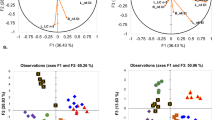Abstract
In Turkey, as an important producer, chickpea is generally planted in March and April during spring. However, spring plantings have the disadvantage of unstable yield and quality from year to year due to irregularity in spring precipitation. In this research, fatty acids and tocopherol contents in different chickpea genotypes were investigated for consecutive 2 years with both autumn and spring plantings. Tocopherol analyses were carried out by using a high performance liquid chromatography. Gamma tocopherol was the major component of total tocopherol content and it ranged between 15.34 and 42.09 mg kg−1. Alpha tocopherol content ranged between 4.55 and 10.69 mg kg−1. Depending on planting time, the values of tocopherol components changed significantly. The mean values for alpha tocopherol were 6.77 mg kg−1 for autumn and 7.55 mg kg−1 for spring plantings; while the mean values for gamma tocopherol were 33.32 mg kg−1 for autumn and 22.50 mg kg−1 for spring plantings, respectively. Fatty acids, quantified using a gas chromatography, indicated that differences among the genotypes were significant. The values for autumn planting were generally higher than those of spring planting. The values of major fatty acids changed between 18.57 and 35.23% for oleic acid and 47.15 and 63.44% for linoleic acid. According to planting time the mean values for oleic acid changed between 21.23 and 30.52% and for linoleic acid between 51.77 and 60.79%.
Similar content being viewed by others
References
Singh U (1985) Qual Plant Foods Hum Nutr 35:339–351
Anonymous (2004) Çanakkale Tarım İl Müdürlüğü
Gül MK, Egesel CÖ, Türk F (2005) Türkiye VI. Tarla Bitkileri Kongresi, 5–9 Eylül Antalya 1:267–269
Özdemir S, Karadavut U (2003) Turk J Agric For 30:183–1888
Amirshahi MC, Tavakoli M (1970) IAEA/FAO, Vienna, 8–12 June 1970, pp 331–335
El Hardallon SB, Salih FA (1981) Legume Res 4:14–18
Nikolopoulou D, Grigorakis K, Stasini M, Alexis M, Iliadis K (2006) Eur Food Res Technol 6:261–265
Mathur K, Singhal S, Sharma RD (1964) J Nutr 84:201
Shobhana Sangwan SP, Nainawatee HS, Lal BM (1976) J Food Sci Technol 13:49–51
Jambunathan R, Singh U (1978) ICRISAT, Hyderabad, India, p 61
Chena CR, Crispin AM, Derra ER (1967) Inst Nac Investieng Agri Mexico 19:45
Khanvilkar SG, Desai BB (1981) J Maharashtra Agric Univ 6:226-228
Ling LY, Robinson RJ (1976) Cereals Food World 21:424
Mosse J, Baudet J (1983) Qual Plant Plant Foods Hum Nutr 32:225–245
Monti LM, Grillo S (1983) Qual Plant Plant Foods Hum Nutr 32:253–266
Hartfiel W and Jakobsen K (1991) In: Flachowsky G, Schöne F, Henning A (eds) Vitamine und weitere Zusatzstoffe bei Mensch und Tier. 3. Symposium 26/27 September 1991 Stadroda bei Jena
Hidiroglou N, Cave N, Atwal AS, Farnworth ER, McDowell LR (1992) Ann Rech Vet 23:337–359
Grela ER, Günter KD (1994) Anim Feed Sci Technol 52:325–331
Berger JD, Ali M, Basu PS, Chaudhary BD, Chaturvedi SK, Pashmukh PS, Dahrmaraj PS, Dwivedi SK, Gangadhar GC, Gaur PM, Kumar J, Pannu RK, Siddique KHM, Singh DN, Singh DP, Singh SJ, Turner NC, Yadava HS, Yadav SS (2006) Field Crop Res 98:230–244
Gupta DK, Tripathi RD, Rai UN, Dwivedi S, Mishra S, Srivastava S, Inouhe M (2006) Changes in amino acids profile and metal content in seeds of Cicer arietinum L. (Chickpea) grown under various fly-ash amendments. Chemosphere (in press)
Thies W (1997) Angew Bot 71:62–67
SAS Institute Inc (1999) SAS/STAT version 8. Cary, NC
Ghirardi P, Marzo A, Ferrari G (1974) Phytochemistry 13:755–756
Marwede V, Gül MK, Becker HC, Ecke W (2005) Plant Breed 124:20–26
Becker HC (1993) Pflanzenzüchtung. Ulmer Verlag, Stuttgart
Author information
Authors and Affiliations
Corresponding author
Rights and permissions
About this article
Cite this article
Gül, M.K., Egesel, C.Ö. & Turhan, H. The effects of planting time on fatty acids and tocopherols in chickpea. Eur Food Res Technol 226, 517–522 (2008). https://doi.org/10.1007/s00217-007-0564-5
Received:
Revised:
Accepted:
Published:
Issue Date:
DOI: https://doi.org/10.1007/s00217-007-0564-5




